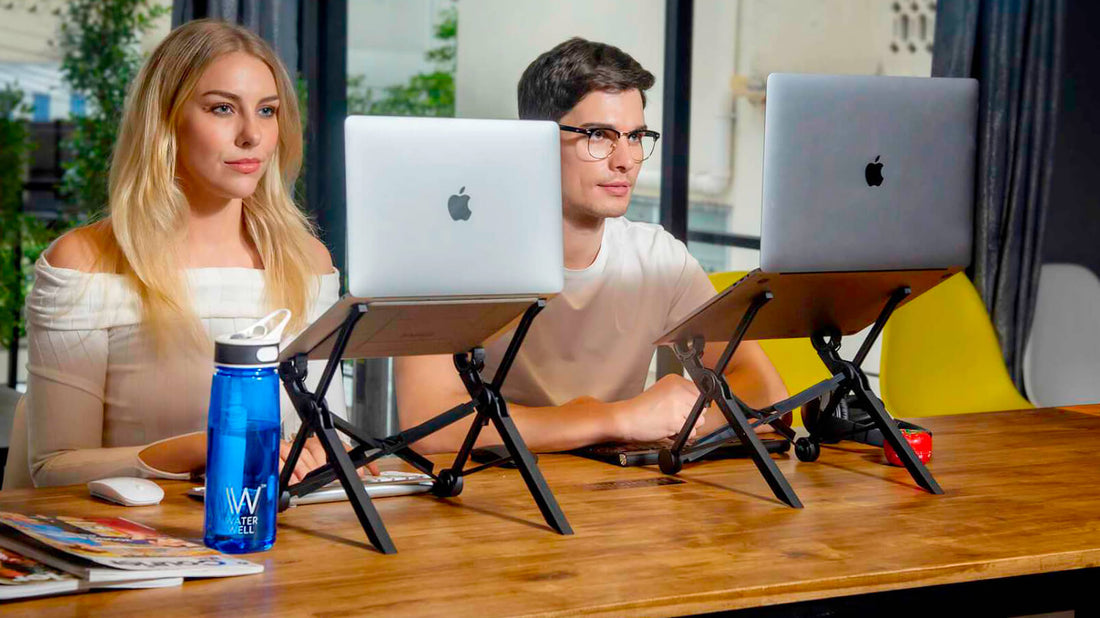Top Tips to Avoid Pain and Injury from Laptop Use

Nicole Copestake

There has never been a more ‘agile’ work community around the world.
An ever improving global infrastructure of digital communication tools coupled with the self realisation for many that we don’t have to work in the same way we always have has sped up the revolution of ‘remote work’.
The traditional office space does however come with some benefits when it comes to solving issues around staff comfort and wellbeing. Many issues can be resolved by buying a great environment.
Such bulky purchases such as chairs, desks, specialist lighting and other furniture items are not compatible with life on the road. So you have to learn to make do with the changing spaces you have available to you.
A solution for a digital nomad therefore has to be as light and as portable as possible.

Nexstand reaches into that space to resolve the main issue. Laptops, those portable devices designed to free us to work anywhere are not designed to be used by us all day.
When they were created, laptops were the answer to being able to carry out onto a customer site some of the data you needed to have to hand for that meeting or to deliver that important PowerPoint presentation to clinch the deal.
Now they are the device of choice and for many people the only computer they have. So for the digital nomad the laptop made sense. However, despite the view from the balcony looking good the pain in the neck or the aching back that comes with hunched postures needs a solution.
Many of the solutions for lifting the computer screen and helping the posture just didn’t do it for someone who chose the laptop in the first place to stay mobile.
“Too bulky”, “It doesn’t really lift the screen high enough”, are things we often heard from users of height adjustable laptop stands.
So Nexstand was born. Lightweight and portable and yet providing one of the best screen height of any solution out there!

Here are some top tips for avoiding physiological damage whilst working on a laptop
-
Try and find a flat surface to work on and sit with your arms at right angles to the work surface.
Sitting too high or too low to a work surface can lead to hunched postures or lifting of the shoulders putting strain on the upper back and neck.
-
Always use a height adjustable laptop stand and an external keyboard and mouse
If using your laptop for more than 10 minutes, use a laptop stand which elevates the monitor height so that it is in line with your eyes when you are sat upright. Don’t type onto an elevated keyboard as this can put strain on your arms. Use a small external keyboard and mouse. A smaller keyboard is recommended to avoid working outside of your neutral arc and over extending your mousing arm which can cause a twist in your posture.
-
Do some postural stretches
Before you start working, do some simple stretches in order to avoid injury. We recommend taking a look at this video channel from postural experts PostureWorx.
This will give you some really simple exercises to do for areas such as the arms and neck.
-
Take regular postural breaks
Avoid static postures which can lead to static muscle strain and also fatigue by taking a regular break away from the computer every hour to go for a short walk. Sitting or standing in one place for any length of time is not good for the body so building in regular movement into your day away from the screen is key.
-
Look after your eyes
Apply the 20:20:20 rule for your eyes. So every 20 minutes look away from your screen and focus on something 20 feet away for 20 seconds. This rests the muscles in your eyes used for computer work and can help prevent deterioration of the eyes.
Avoid screen glare which can cause damage to the eyes and potential headaches by tilting the screen slightly and where possible using something to reduce direct sunlight onto the screen. The BASE12 laptop tent from Nexstand is an ideal solution for this. Lightweight and easy to carry, it simply pops open to provide a sun shield for the laptop and works alongside our K2 laptop stand.

-
Keep hydrated
This doesn’t mean just sit there drinking coffee! Drinks with caffeine in may have a diuretic effect on the kidneys, especially in high doses.
Drinking water regularly throughout the day will keep your body hydrated and will help both muscles and your spine to stay healthy. Your spine has intervertebral discs which contain fluid and water is required to maintain a healthy fluid balance and to cushion the bone.
For the regular travelling remote worker we recommend you purchase a WaterWell bottle which will reduce plastic waste caused by buying single use bottled waters and will enable you to fill up as you go rather than carrying heavy water. The WaterWell features a special two stage filter which will filter water to 0.1 microns giving you cleaner, safer water from the water sources available to you.

